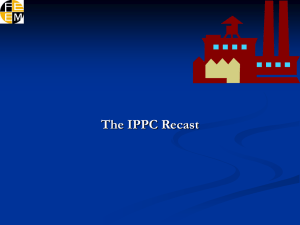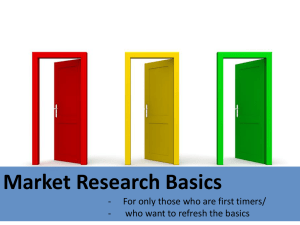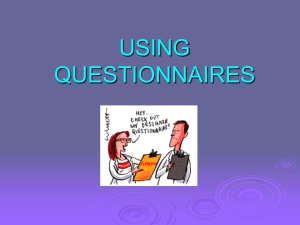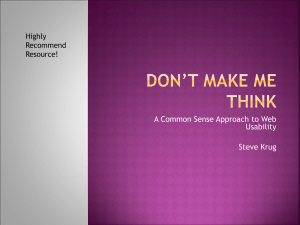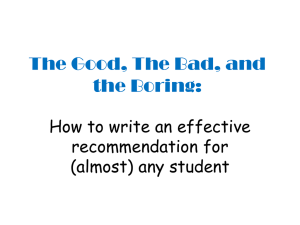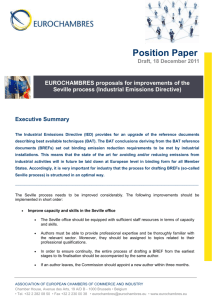2014-07-11-14-WT-BREF-Questionnaire-Launch
advertisement
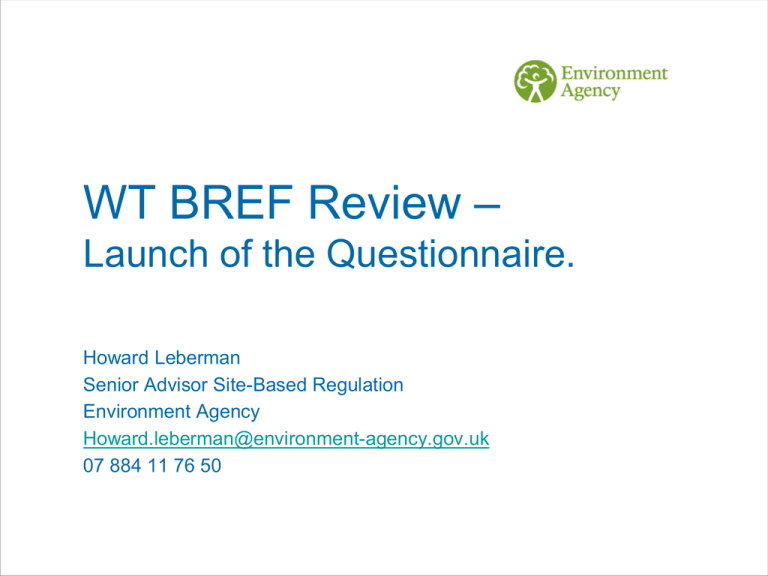
WT BREF Review – Launch of the Questionnaire. Howard Leberman Senior Advisor Site-Based Regulation Environment Agency Howard.leberman@environment-agency.gov.uk 07 884 11 76 50 BREF process BREF BAT conclusions are adopted through Committee procedure and are the reference for setting permit conditions to installations covered by the IED. The BREFs inform the regulatory bodies about what may be technically and economically available to industry in order to improve their environmental performance and consequently improve the whole environment. IED –BAT REF Documents Standard format Preface, Scope Chapter 1 - General Information about the sector concerned Chapter 2 - Applied Processes and Techniques Chapter 3 - Current Emission and Consumption levels Chapter 4 - Techniques to Consider in the determination of BAT including economics Chapter 5 - BAT Conclusions Chapter 6 - Emerging techniques Concluding remarks, future work, References, Glossary of terms, Annexes Article 13 Forum – MS/Industry/NGOs Members are invited to submit comments on draft BREFs before the Art 13 meeting. Comments are classified as: ‘Consensual’ – these will normally be adopted; ‘Consensual with modification’ – the Commission will seek to propose a form of words to make ‘Consensual’; ‘The views of certain MS’ – only discussed if MS really presses the point. Commission considers comments and makes changes as it sees fit. Article 75 Committee – MS only MS are invited to discuss final draft BREF. There normally follows a ‘shadow’ vote. Further discussions. Formal vote – qualified majority Germany, France, UK, Italy – 29 Spain, Poland - 27 Romania – 14 Netherlands – 13 Greece, Portugal, Belgium, Czech Rep, Hungary – 12 Sweden, Bulgaria, Austria – 10 Denmark, Slovakia, Finland, Croatia, Ireland, Lithuania – 7 Slovenia, Estonia, Cyprus, Luxembourg – 4 Malta - 3 Opportunities to Influence Technical Working Group – high. Article 13 Forum – medium but comments need to have broad support [consensual] and be presented in a way that persuades the UK permanent representative to address Commission. Points to raise 2-3 max. Article 75 Committee – very limited – major ‘show stoppers’ only. Points to raise MUST be so serious that failure to address would warrant a UK vote against or abstention. WT BREF -Technical Working Group Member States - AT, BE, BG, CY, HR, CZ, DK, FI, FR, DE, EL, HU, IE, IT, MT, NL, PL, PT, RO, SK, SI, ES, SE, UK. EEA Member States as observers. Industrial NGOs - CEFIC, CEMBUREAU, CEPI, CEWEP, CONCAWE, EBA, ECN, EFR, EPPSA, ERFO, ESRG, ESWET, EUCOPRO, EURITS, EUROFER, EUROMETAUX, EUPR, FEAD, GEIR, HWE, MWE, ORGALIME. WT BREF Sub Groups Bio-wastes – Unico van Kooten [Dutch WMA]. • General techniques & Indoor composting – Kiara Zennaro [REA]. • Open air composting – Florian Amlinger [ARGE Kompost & Biogas Austria] • AD – David Wilken [German Biogas Association]. • MBT – Isabelle Pace [Veolia France]. Mechanical - Jochen Ebbing [German Institute of WM] & Ross Bartley [EFR]. • Shredding of non-hazardous metal containing wastes. • SRF/RDF production. • Shredding of fridges, freezers and air-conditioning units. Physico-chemical - Nicolas Humez [HW Europe]. WT BREF UK Working group Howard Leberman – EA, UK WT BREF lead. Leslie Heasman - ESA, Physico-chemical. Howard Bluck - BMRA, Metal shredding. Tina Benfield - CIWM, Bio-wastes & other. Kiara Zennaro – REA, Bio-wastes. Jakob Rindegren – ESA, Bio-wastes . Dorian Harrison – ADBA, AD. SEPA – Fiona Donaldson. NRW – Julie Tate. NIDoE – Michael Moody. European reference plant 556 sites proposed across 17 Member States. Of this: Germany – 119 sites France – 70 UK – 64 Italy - 57 Austria - 40 Belgium – 34 Netherlands – 31 Spain – 30 Remaining 9 MS -111 sites Types of UK plant 20 plant - Aerobic treatment. 12 - Anaerobic treatment. 06 - Physico-chemical treatment of high calorific wastes. 05 - Reuse of waste oils. 04 - Mechanical treatment in shredders of metal waste. 04 - Other e.g. plasma smelting; chemical sterilisation . 03 - Immobilisation of solid & pasty wastes. 02 - Blending/mixing. 02 - Mechanical treatment of high calorific waste. 02 - Physico-chemical treatment of liquid wastes. 02 - Regeneration of spent solvents. 01 - MBT. 01 - Repackaging. The questionnaire Information submitted in the questionnaire will be used solely for the purpose of the review of the WT BREF. Questionnaire is focused on emission & consumption data. This should not be confidential. If confidential, the reasons for claiming confidentiality should be raised with Howard Leberman. If considered confidential, information will be anonymised in the BREF and TWG. The confidential information will remain the responsibility of the EA and EICCPB and will not be distributed. Questionnaire worksheets Waste treatment activity. Waste input & output. Waste input & output characteristics. Storage & common steps. Process – Mechanical; Biological; Physico-chemical. Emissions to air & water. Water consumption. Raw materials consumption. Energy consumption. BAT candidate(s). General instructions Questionnaire should be completed using Microsoft Excel. Macros must be enabled. Always use the drop down menu & predefined options – free-text fields are available. Tool-tips provide instructions or guidance on how to answer the questions. Make use of the comments cell – to identify if data is estimated; if in a different format to that requested; .... Data reference years – 2010, 2011, 2012; Data from other years allowed but you must identify the reference period. How many questionnaires? The purpose is to relate the information & data to a waste technique. One installation can have several reference plant – one questionnaire for each [copy & rename the first – then amend]. Multiple questionnaires may also be required • Multiple emission sources; • Different waste inputs leading to significant differences in emissions; • Where significant year-dependant details are required. Questionnaire time-line All questionnaires to be submitted onto BATIS by 31 October 2014. Questionnaire will need to be checked & submitted by the MS. Completed UK questionnaires requested by end of September or earlier. Send by email to howard.leberman@environment-agency.gov.uk Bureau’s time-line July 2014: Bureau shares working document on Scope of BAT conclusions (drafting of the text is ongoing). Autumn 2014: Bureau shares working document on BREF structure (based on subgroup documents and data collection). Bureau drafting D1 on the basis of collected data and information. Support Trade bodies, Or Howard.leberman@environment-agency.gov.uk
